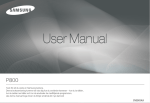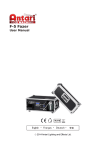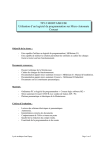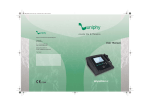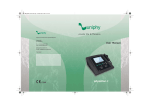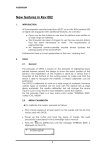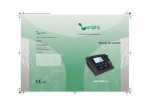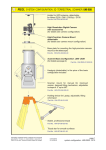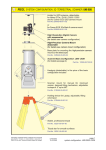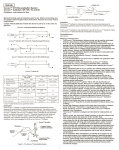Download xt20_repair_manual
Transcript
XT20 Cross Trainer Repair Manual SPORTSART INDUSTRIAL CO., LTD. . Contents 1. Component Recognition 1-1-1. XT20 Picture 1-2-1. XT20 Display 1-3-1. XT20 Lower Body (Rear) 1-3-2. XT20 Lower Body (Front) 1-4-1. XT20 Display 1-5-1. XT20 Display Board (Front) 1-5-2. XT20 Display Board (Back) Note: XT10 and XT20 are mechanically and electronically identical. The only difference is in their displays. The residential model XT10 has user programs. The commercial model XT20 does not have user programs. For general troubleshooting, this manual applies to XT10 and XT20. 2. XT20 Functions 2-1-1. XT20 Specification Table 2-2-1. XT20 Display Window Functions 2-3-1. XT20 Display Key Functions Manual updates follow: Version 1: 12-07-05 – Initial version Version 2: 02-01-06 – Note below added 3. XT20 Operation 3-1-1. Battery Start Up 3-1-2. Alternator Start Up 3-1-3. Quick Start Mode 3-1-4. Operating from Quick Start Mode 3-1-5. LEG/ARM Work Level Setting 3-1-6. Start Mode 3-1-7. Operate Programs 3-1-8. Operating Programs (Cont.) 3-1-9. Stopping Programs 3-1-10. Battery Shut Off 3-1-12. Show Total Distance 3-1-13. Set KPH/MPH Mode Note: The cover picture shows a prototype with handles (like the C5150 bike). Production units of XT10 and XT20 never had such handles. For comments or suggestions, please contact [email protected]. 0-0-1 . Contents 4. Block Diagrams 4-1-1. XT20 Display Board Wire Connection Block Diagram 4-1-2. XT20 Drive Board Wire Connection Block Diagram 5. Connections and Components on Boards 5-1. Display Board 5-1-1. XT20 Display Board Wire Connection Block Diagram 5-1-2. XT20 Display Board Component Placement 5-1-3. XT20 Display Board LED Indicators 5-1-4. XT20 Display Board Wire Connectors 5-2. Drive Board 5-2-1. XT20 Drive Board Wire Connection Block Diagram 5-2-2. XT20 Drive Board Component Placement 5-2-3. XT20 Drive Board LED Indicator Placement and Definitions 5-2-4. XT20 Drive Board Wire Connectors 5-2-5. XT20 Drive Board Fuse Locations 0-0-2 Contents 6. Error Messages 6-1-1. Unit Does Not Start when Keys Are Pressed. (Continued on 6-1-2.) 6-2-1. Move the Pedals or Arms; The Display Does Not Light. (Continued on 6-2-2.) 6-3-1. Move the Pedals or Arms; The Display Leg or Arm RPM Window Shows 0. (Cont. 6-3-2.) 6-4-1. There is No Resistance on Arms or Legs. (Continued on 6-4-2.) 6-5-1. Remote Key Malfunction (Continued on 6-5-2.) 6-6-1. The Battery Does Not Recharge (Continued on 6-6-2.) 6-7-1. Polar Heart Rate Malfunction (Continued on 6-7-2.) 7. Electronic Component Testing 7-1-1. XT20 Alternator Test (Continued on 7-1-2.) 7-2-1. XT20 Battery Voltage Test 7-3-1. XT20 Electro-Magnet Test 7-4-1. XT20 Reed Switch Test (Continued on 7-4-2.) 7-5-1. XT20 Alternator Power Test at the Drive Board (Continued on 7-5-2.) 7-6-1. XT20 Battery Test at the Drive Board (Continued on 7-6-2.) 7-7-1. XT20 Resistance Voltage Test at the Drive Board (Continued through 7-7-3.) 7-8-1. XT20 VCC Voltage Test at the Drive Board (Continued on 7-8-2.) 7-9-1. XT20 VCC Voltage Test at the Display Board (Continued on 7-9-2.) 7-10-1. XT20 Display Board Key Test 7-11-1. XT20 Arm Remote Key Test (Continued on 7-11-2.) 7-12-1. XT20 Polar Heart Rate Test (Continued on 7-12-2.) 7-13-1. Addendum: XT20 Drive Board Overview; Voltage Specifications (7-13-2) 0-0-3 . XT20 Picture 1-1-1 . XT20 Display 1-2-1 . XT20 Lower Body (Rear) Electromagnet Drive board Flywheel AC alternator Reed switch and magnet 1-3-1 . XT20 Lower Body (Front) Reed switch AC alternator Flywheel Battery Electromagnet 1-3-2 XT20 Display 1-4-1 XT20 Display Board (Front) 1-5-1 XT20 Display Board (Back) 1-5-2 XT20 Specification Table Function Heart rate Main window Mode window Program window Heart rate detection Key Work level Power Backup Power Resistance Seat Electronic Specifications Specifics Telemetry heart rate 65% HR target 80% HR target Moving prompts or illustrations Dot matrix 5*5*8 LED two-color dot matrix (red/green) Work Lever(LEG)/ Work Lever(ARM) CALORIES / CAL / HR / DISTANCEMETS / WATTS LEG RPM / TIME / ARM RPM MANUAL / RANDOM / CARDIO / WT LOSS / CONDITONING / ADVANCED CONDITONING POLAR wireless telemetry heart rate Key/ toggle switch Work level(LEG)1~20 Work level(ARM)1~20 Hand/leg independent power generation Rechargeable battery (hand/leg independent batteries) Leg: electro-magnetic (belt drive) Arm: electro-magnetic (chain drive) Adjustable back Adjustable seat Rechargeable battery: 6.4 V Alternator: AC brushless Resistance voltage – arm: 2.0~10.2V Resistance voltage – leg: 2.7~17.2V 2-1-1 Model XT20 XT20 XT20 XT20 XT20 XT20 XT20 XT20 XT20 XT20 XT20 XT20 XT20 Display Window Functions Heart rate ÎShows 65% HR target ÎShows actual heart rate ÎShows 80% HR target Main window ÎShows prompts and illustrations Leg work level ÎShows leg resistance level value Arm work level ÎShows arm resistance level Calorie ÎShows calorie burn and calorie burn per hour Leg RPM Î Shows rotations per minute (leg) METS ÎShows METS and WATTS values Time ÎShows time Distance ÎShows distance 2-2-1 Arm RPM ÎShows rotations per minute (arm) XT20 Display Key Functions <MANUAL> ÎKeys directly determine settings <RANDOM> ÎAutomatic random resistance changes <CARDIO/WT LOSS> ÎAutomatic control according to heart rate setting <CONDITIONING> ÎAutomatic physical conditioning program (1) <ADVANCED CONDITIONING> ÎAutomatic physical conditioning program (2) ARM WORK LEVEL<▲>/<▼> ÎSet ARM resistance level <START>Î start by inputting personal information <QUICK START>Î start without inputting personal information <ENTER>Î confirm your selection LEG WORK LEVEL<▲>/<▼> ÎSet LEG resistance level <STOP/RESET>Îstop/reset 2-3-1 1. Battery Start Up Function: 1. Use battery power to activate the unit. Operation: 1. Press <START>. The display shows “XT20” and starts operating as shown below. 3-1-1 2. Alternator Start Up Function: 1. Use power from the alternator to activate the unit. Operation: 1. Move the pedals or handles. The display shows “XT20” and starts operating as shown below. Left Picture Right Picture 3-1-2 3. Quick Start Mode Function: 1. Start exercising without inputting personal settings. Operation: 1. To start exercising, press <QUICK START> after the display shows “XT20”. The display will appear as shown below on the left. 2. Move the pedals or handles. Time accumulates from 0:00. 3. Press <STOP/RESET>. Exercise mode stops. The startup screen appears as shown on the right. Left Picture Right Picture 3-1-3 4. Operating from Quick Start Mode Function: 1. Exercise from QUICK START in manual mode Operation: 1. The default settings in this exercise mode follow: age is 35; weight is 75Kg/165Lb; arm resistance is 3; leg resistance is 5. 2. The course is represented by an oval track. Green dots represent area yet to cover; orange represents current location; red represents area already covered. See picture below left. 3. While you exercise, CALORIES/CAL HR, DISTANCE, METS/WATTS values show. Distance values accumulate. RPM values appear for both legs and arms. See picture below right. 4. Directly press LEG WORK LEVEL▼/▲ or ARM WORK LEVEL▼/▲ keys to control resistance settings. Left Picture Right Picture 3-1-4 5. LEG/ARM Work Level Setting Function: 1. Set LEG/ARM resistance level. Operation: 1. Press the LEG/ARM Work Level ▼/▲ key on the display or press the ┼/— key on the handle to change LEG and ARM resistance settings. Left: display keys. Right: handle keys. 2. Left handle ┼/— keys set leg resistance. Right handle ┼/— keys set arm resistance. Resistance setting range: 1~20. Left Picture Right Picture 3-1-5 6. Start Mode Function: 1. Exercise using user personal information for more accurate physical feedback readings. Operation: 1. Press <START> after the display shows “XT20” to input user information. The display appears as shown on the left. 2. To enter age and weight, press ▲\▼ keys or numbers on the bottom of the display. Press <ENTER> to confirm your choice as shown below on the right. 3. After pressing <ENTER>, the display, automatically calculates calorie burn, etc., according to your information. Left Picture Right Picture 3-1-6 7. Operate Programs Function: 1. Operate automatic programs. Operation: 1. After entering age and weight information, all program LEDs light as shown on the left. 2. Press any key (MANUAL、RANDOM、CARDIO/WT LOSS、CONDITIONING、ADVANCED CONDITIONING) as shown on the right to activate the related program. 3. Programs explanations follow: (1) MANUAL-directly set resistance; (2) RANDOM-resistance changes at random; (3) CARDIO-aerobic conditioning; WT LOSS-weight loss mode; (4) CONDITIONING-physical conditioning; (5) ADVANCED CONDITIONING – advanced physical conditioning. Left Picture Right Picture 3-1-7 8. Operating Programs (Cont.) Function: 1. Other program operation. Operation: 1. After entering a program (MANUAL、RANDOM、CARDIO/WT LOSS), press ▲\▼ keys on the display or handles to enter the time, then press <ENTER> to confirm your choice. 2. In CONDITIONING and ADVANCED CONDITIONING modes, press these keys again to toggle between four options, P1~P4. Exercise time is pre-set. Press <ENTER> to confirm your choice of programs. The display appears as shown on the right. Left Picture Right Picture 3-1-8 9. Stopping Programs Function: 1. Program mode values and prompts. Operation: 1. In program modes, press <STOP> to halt the program. The display appears as shown on the left. 2. After stopping, the display shows total distance, calorie expenditure, and time. See right. 3. To resume your workout, hold the <STOP/RESET> key two seconds. The display will reset. Left Picture Right Picture 3-1-9 10. Battery Shut Off Function: 1. Automatically turn off the unit after exercising. Operation: 1. Simultaneously press <ENTER>+LEG Work Level <▼> to turn off the display. The battery circuit is disengaged, and the display shuts off as shown on the right. Picture Left Picture Right 3-1-10 11. Power Save Mode Function: 1. Start the power saving mode. Operation: 1. When there is no movement signal detected for over 30 seconds, the display automatically shuts off and a “bouncing ball” pattern appears. 2. Press <START> or move the pedals or handles to resume exercising. The display shows the previous screen as shown on the right. Left Picture Right Picture 3-1-11 12. Show Total Distance Function: 1. See total distance. Operation: 1. Simultaneously press <STOP/REST>+<ENTER>+<DISPLAY Lock> keys. The display appears as shown. K: KPH M: MPH Program nationality Total distance 3-1-12 13. Set KPH/MPH Mode Function: 1. Set unit operation in KPH or MPH mode. Operation: 1. At the startup screen, simultaneously press LEG Work Level <▼/▲> keys to enter the MODIFY setting. 2. Then press<▼/▲> to toggle to YES. Press <ENTER> to confirm your choice. See picture on left. 3. Press ▼/▲ keys to toggle between KG and LB. Then press <ENTER> to confirm your choice. See right. Left Picture Right Picture 3-1-13 XT20 Display Board Wire Connection Block Diagram Polar Board Display Board Drive Board 4-1-1 C-Safe Board XT20 Drive Board Wire Connection Block Diagram 控制板 Display Board Arm 手部 Leg 腳部 電磁鐵 Magnet Electro- Electro電磁鐵 Magnet Reed Switch 磁簧感應線 Reed Switch 磁簧感應線 Alternator 發電機 Alternator 發電機 Drive Board 驅動板 Battery 充電器 Charger 紅外線按 Infrared Key Board 鍵小板 Battery 蓄電池 搖臂按鍵 Keys Handle 4-1-2 XT20 Display Board Wire Connection Block Diagram Polar Board Display Board Drive Board 5-1-1 C-Safe Board XT20 Display Board Component Placement 5-1-2 XT20 Display Board LED Indicators POWER1 LED ÎLit=5V power supply LED1 C-SAFE Indicator ÎLit=C-SAFE operation 5-1-3 XT20 Display Board Wire Connectors CON1 ÎTo drive board CON4 ÎTo C-SAFE board CON2 Î To POLAR receiver board 5-1-4 XT20 Drive Board Wire Connection Block Diagram 控制板 Display Board Arm 手部 Leg 腳部 電磁鐵 Magnet Electro- Electro電磁鐵 Magnet Reed Switch 磁簧感應線 Reed Switch 磁簧感應線 Alternator 發電機 Alternator 發電機 Drive Board 驅動板 Battery 充電器 Charger 紅外線按 Infrared Key Board 鍵小板 Battery 蓄電池 搖臂按鍵 Keys Handle 5-2-1 XT20 Drive Board Component Placement 5-2-2 XT20 Drive Board LED Indicator Placement and Definitions LED2 ARM_CLK ÎFlashing or becoming lit indicates detection of ARM reed switch signal. LED1 LEG_CLK Î Flashing or becoming lit indicates detection of LEG reed switch signal. 5-2-3 XT20 Drive Board Wire Connectors J4 ÎTo reed switch, electro-magnet, alternator (arm) J2 ÎTo display board J8 ÎTo battery charger J5 ÎTo reed switch, electro-magnet, alternator (leg) J1 J3/J7 ÎTo battery ÎJ3, To right handle keys ÎJ7, To left handle keys 5-2-4 XT20 Drive Board Fuse Locations F1 3A Alternator fuse F2 2A Battery fuse F3 2A Battery charger fuse 5-2-5 . XT20 Error Messages: Unit does not start when keys are pressed. 1. Explanation: 1. Press <START> or <Quick START> keys on the display. The display does not light. 2. Block diagram: Display Board 按STAR StartT o Power LED Quick 或Q UI CK Start START Keypad Keypad CABLE 控制板 Drive Board 驅動板 Voltage 開機電壓 Battery 蓄電池 Fuse F2 保險絲F2 6-1-1 POWER ◎ 3. Circumstance of Malfunction: 1. Display does not light up. 4. Possible Causes: 1. Battery is bad. 2. Drive board is bad. 3. Display board is bad. 4. Data cable is bad. 5. Parts to Inspect: Order Part 1 Battery 2 Drive board 3 Display board 4 Data cable Inspection Procedure 1. Test whether battery voltage exceeds 5.5V. If not, recharge battery. If not possible, replace the battery. 1. Test battery fuse F2 on the drive board F2 for continuity. Replace if necessary. 2. Inspect drive board wire connections. Reconnect if necessary. 1. Inspect the data cable connection to the display. 2. Inspect whether the power LED on the display lights up. 1. Inspect the cable for breaks or shorts. 2. Inspect cable connections from the display to the drive board. 6-1-2 . XT20 Error Message: Move the pedals or arms. The display does not light. 1. Explanation: 1. When pedals or arms move, the alternator power goes to the drive board; the display detects the reed switch signal, and the display lights up. 2. Without either the alternator voltage or the reed switch signal, the display cannot light. 2. Block Diagram: Display 控制板 Board POWER Arm 手 部 Reed Switch Leg 腳 部 磁簧感應線 Display 驅 動 Board 板 CL K Reed Switch 磁簧感應線 CL K Alternator 發電機 Alternator 發電機 V L ED1 L ED2 CLK Indicators CL K 指示燈 6-2-1 V 3. Circumstance of Malfunction: 1. Move the pedals or arms; the display does not light up. 4. Possible Causes: 1. Reed switch malfunction 2. Drive board malfunction 3. Display board malfunction 4. Break in the data cable 5. Alternator malfunction 5. Parts to Inspect: Order Part 1 Reed switch 2 3 4 5 Drive board Display board Data cable Alternator Inspection Procedure 1. Inspect the reed switch wire connection. 2. Inspect the LED1 and LED2 indicators on the drive board. 1. Inspect the LED1 and LED2 indicators on the drive board. 1. Inspect the display board for a malfunction. 1. Inspect all cables and their connections. 1. Inspect the alternator. 6-2-2 . XT20 Error Message: Move the pedals or arms; the display leg or arm RPM window shows 0. 1. Explanation: 1. The display board CPU reads the reed switch signal and displays values in the leg and arm RPM windows. 2. If the display cannot read the reed switch signal, RPM values cannot be shown. 2. Block Diagram: Display 控 制Board 板 腳Leg 部 CLK CL K Arm 手 部 CLK CL K Reed Switch 磁簧感應線 驅Drive 動板 Board 蓄電池 Battery LED1 LED2 Indicators 6-3-1 Reed Switch 磁簧感應線 3. Circumstance of Malfunction: 1. Move the pedals or arms; the display does not show leg and arm RPM speed in respective windows. 4. Possible Causes: 1. Reed switch or reed switch wire malfunction 2. Drive board malfunction 3. Display board malfunction 4. Wires are disconnected or broken. 5. Parts to Inspect: Order Part 1 Reed switch wire 2 3 4 Drive board Display board Cables Inspection Procedure 1. Inspect the reed switch wire connection. 2. Inspect LED1 and LED2 on the drive board. 1. Inspect LED1 and LED2 on the drive board. 1. Inspect the display board for a malfunction. 1. Inspect all cables and their connections. 6-3-2 . XT20 Error Message: There is no resistance on arms or legs. 1. Explanation: 1. The reed switch CLK signal does not reach the display CPU. The unit does not start. There is no resistance. 2. The display has not sent the resistance signal to the drive board. The drive board has not sent voltage to the electro-magnet, so there is no resistance. 2. Block Diagram: Display 控制板 Board CABLE 阻 CLK CLK Alternator 發電機 號 V Reed 磁簧感應線 Switch AC Voltag AC 電壓 e Resistance 力 Signal 訊 Drive 驅動板 Board 6-4-1 Electro電磁鐵 Magnet Resistance 阻力電壓 Voltage 3. Circumstance of Malfunction: 1. There is no resistance on legs or arms. 4. Possible Causes: 1. Reed switch or wire malfunction 2. Drive board malfunction 3. Display board malfunction 4. Cable malfunction 5. Electro-magnet malfunction 6. Alternator malfunction 5. Parts to Inspect: Order 1 2 3 4 5 6 Part Reed switch and wire Drive board Display board Cable Electro-magnet Alternator Inspection Procedure 1. Inspect the reed switch and wire. 1. Inspect whether the drive board is sending voltage to the magnet. 1. Inspect whether the display board is malfunctioning. 1. Inspect cables and their connections. 1. Inspect the electro-magnet. 1. Inspect the alternator. 6-4-2 . XT20 Error Message: Remote Key Malfunction 1. Explanation: 1. When the unit is on, the user presses remote keys, but there is no response from the display. 2. Block Diagram: Display 控制板 Board 左 手 Left 左 手 Right Remote 搖臂按鍵 Keys Remote 搖臂按鍵 Keys Infrared 紅 外 線Transmitter 發射器 驅動 板 Drive Board Infrared 紅 外 線Transmitter 發射器 按鍵訊號 紅Infrared 外 線 Receiver 接受器 Key Signal 6-5-1 紅Infrared 外 線Receiver 接受器 3. Circumstance of Malfunction: 1. When the display is lit, the user presses remote keys, but the display does not respond. 4. Possible Causes: 1. Remote keys 2. Infrared transmitter 3. Infrared receiver 4. Drive board malfunction 5. Display board malfunction 6. Cable malfunction 5. Parts to Inspect: Order 1 Part Remote keys 2 Infrared transmitter 3 4 5 6 Infrared receiver Drive board Display board Cables Inspection Procedure 1. Inspect keys and the key circuit board. 1. Inspect the infrared transmitter batteries. 2. Inspect the infrared transmitter. 1. Inspect the infrared receiver. 1. Inspect the drive board wire connections. 1. Inspect the display board wire connections. 1. Inspect all cables and their connections. 6-5-2 . XT20 Error Messages: The battery does not recharge. 1. Explanation: 1. At a speed of 40 RPM or higher, the drive board emits power to replenish the battery. 2. The drive board does not send voltage to the battery; the battery does not recharge. 2. Block Diagram: Display Board 控制板 Arm 手部 Alternator 發電機 Leg 腳部 AC Voltage AC電壓 AC AC電壓 Voltage Alternator 發電機 Drive Board 驅動板 DC Voltage DC電壓 Battery 蓄電池 6-6-1 3. Circumstance of Malfunction: 1. The alternator does not provide AC power to the rectifier board. 2. The drive board does not provide DC voltage to recharge the battery. 4. Possible Causes: 1. Alternator malfunction 2. Drive board malfunction 3. Battery malfunction 4. RPM value does not meet or exceed 40 RPM, so there is no opportunity to recharge the battery. 5. Parts to Inspect: Order 1 Part Alternator 2 Drive board 3 Battery Inspection Procedure 1. Inspect the alternator for AC voltage to the drive board. 1. Inspect the F1 and F2 fuses on the drive board. 2. Inspect whether the drive board provides DC voltage to the battery. 1. Inspect the battery wire connections. 2. Inspect whether battery voltage is lower than 3V. If so, the battery is defective; replace it. 6-6-2 . XT20 Error Message: POLAR heart rate malfunction 1. Circumstance of Malfunction: 1. There is no POLAR heart rate value on the display. 2. The POLAR heart rate value is not accurate. 2. Block Diagram: Heart Rate Signal Heart Rate Signal Display Board Heart Rate Receiver 6-7-1 Heart Rate Transmitter . 3. Possible Causes: 1. 2. 3. 4. 5. POLAR heart rate transmitter malfunction POLAR heart rate receiver malfunction; receiver does not detect transmitter signal. POLAR heart rate receiver interference POLAR heart rate 3-PIN cable is not connected. Display malfunction: CPU does not detect the POLAR heart rate signal. 4. Parts to Inspect: Order 1 2 3 4 Part POLAR heart rate transmitter POLAR heart rate receiver Inspection Procedure 1. Inspect the transmitter and brand. 2. Replace the transmitter. 1. Inspect the POLAR receiver board position. Some positions detect better than others. 2. Inspect the POLAR heart rate receiver board for component connections. 3-pin cable connection 1. Inspect POLAR heart rate board wire connections. Display board 1. Inspect the 3-pin cable connections. 2. Press on the display board IC chip to reinsert pin connections. 6-7-2 . XT20 Alternator Test 1. Alternator test configuration: 7-1-1 . 2. Test Procedure: 2-1. Put voltmeter to the 200 VAC setting. Inspect any two wires from the alternator for voltage as shown. 2-2. When the arms or legs are moving, voltmeter shows voltage; the faster the movement, the greater the voltage. 3. Troubleshooting: 3-1. If there is no voltage, (1) Inspect all wire connections; (2) Inspect AC alternator. Replace if necessary. 7-1-2 . XT20 Battery Voltage Test 1. Test Configuration: 2. Test Procedure: 2-1. Put voltmeter to the 20 VDC setting. 2-3. Place probes as shown, with the red on the red terminal, the black on the black terminal. 2-4. Normal voltage: 5.6 ~6.5 VDC. If lower than 5.5 VDC, please move the pedals or arms swiftly to recharge the battery. 3. Troubleshooting: 3-1. If there is no voltage, or voltage is too low: (1) Inspect the battery wire connections. (2) Inspect whether fuse F2 has broken. 3-2. Recharge the battery by moving at 40 RPM or more. 7-2-1 . XT20 Electro-Magnet Test 1. Test Configuration: 2. Test Procedure: 2-1. Disconnect the CN2 wire connection from the drive board. 2-2. Put the voltmeter to the ohm setting. Place probes as shown on the two, blue wires of the magnet. 2-3. Normal ohm specification: 20. 2-4. If greater than 20 or open, the electro-magnet it bad. Replace it. 3. Troubleshooting: 3-1. If the reading is not normal, inspect: (1) The electro-magnet wire connections. (2) The cable and connections from the magnet to the drive board. 7-3-1 . XT20 Reed Switch Test 1. Test Configuration: Left Picture Right Picture LED1、LED2 CLK 2. Test Procedure A. Arm RPM 1. Press the<START>key. The display lights up. 2. Move the arms. The drive board CLK LED flashes. Display shows<ARM RPM>value. 3. Move the arms once per second. The display<ARM RPM>window shows 60 RPM. 7-4-1 . XT20 Reed Switch Test 2. Test Procedure: B. Leg RPM 1. Press the<START>key. The display lights up. 2. Move the pedals. Drive board CLK LED flashes. Display shows the<LEG RPM>value. 3. Move the arms once per second. The display <LEG RPM>window shows 60 RPM. 3. Troubleshooting: 1. If your test results differ, the reed switch is unstable or bad. 7-4-2 . XT20 Alternator Power Test at the Drive Board 1. Test Configuration: 7-5-1 . 2. Test Procedure: 2-1. Put voltmeter to the 200 VDC setting. Place probes on the drive board TP1-TP2 connectors as shown. 2-2. Move either pedals or arms. Normal voltage: 10-150 VDC or more. 2-3. If not as above, the alternator is bad. 3. Troubleshooting: 3-1. If there is no voltage, inspect: (1) All cable connections. (2) F1 fuse on the drive board. Replace if necessary. (3) Inspect alternator for damage. 7-5-2 . XT20 Battery Test at the Drive Board 1. Test Configuration: 7-6-1 . 2. Test Procedure: 2-1. Put voltmeter to the 20 VDC setting. Place probes separately on J1 red and black terminals. Normal reading: 6 volts. 2-2. If less than 5.5 VDC, recharge the battery. 5.3 VDC is the lowest voltage at which the display can operate. 2-3. To recharge the battery, exercise at 40 RPM or more for 20 minutes or more. 2-4. If the battery has less than 3 VDC, replace it. 3. Troubleshooting: 3-1. If battery voltage is less than 5.5 VDC, recharge the battery as follows: A. Exercise: Exercise at more than 40 RPM for 20 minutes or more, to recharge the battery. B. Battery charger: Connect the XT-20 battery charger. 7-6-2 XT20 Resistance Voltage Test at the Drive Board 1. Test Configuration - ARM Resistance Voltage Test 7-7-1 Test Configuration - LEG Resistance Voltage Test 7-7-2 2. Test Procedure ARM Resistance Voltage Test (1) Put voltmeter to the 20 VDC setting. Place probes on J5 blue-blue wire connectors. Move arms. (2) Press ARM LEVEL<▲> key until the display shows resistance level 20. Arm resistance is highest. Normal voltage reading: 10 VDC approximately. (3) Press ARM LEVEL<▼> key until the display shows resistance level 1. Arm resistance is lowest. Normal voltage reading: 2.0 VDC approximately. LEG Resistance Voltage Test (1) Put voltmeter to the 20 VDC setting. Place probes on J6 blue-blue wire connectors. Move arms. (2) Press LEG LEVEL<▲> key until the display shows resistance level 20. Leg resistance is highest. Normal voltage reading: 17.2 VDC approximately. (3) Press LEG LEVEL<▼> key until the display shows resistance level 1. Leg resistance is lowest. Normal voltage reading: 2.7 VDC approximately. 3. Troubleshooting: (1) If there is no voltage, the drive board is not emitting voltage for resistance. Inspect: A. Cable connections B. Alternator C. Alternator fuse on the drive board D. Drive board E. Display board 7-7-3 . XT20 VCC Voltage Test at the Drive Board 1. Test Configuration: Normal reading: 5 VDC. 7-8-1 . 2. Test Procedure: 2-1. Put voltmeter to the 20 VDC setting. Place probes on the drive board J2 pin1-pin18 terminals as shown. This is the VCC circuit. 2-2. Exercise on the unit or press the <START> or <QUICK START> key on the display. The display should beep once and light. 2-3. Normal reading: 4.8-5.2 VDC approximately. 3. Troubleshooting: 3-1. If the display does not light. (1) Inspect cable connections. (2) Inspect fuses on the drive board. Replace if necessary. 7-8-2 XT20 VCC Voltage Test at the Display Board 1. Test Configuration: Capacitor C10 7-9-1 2. Test Procedure: 2-1. Put voltmeter to the 20 VDC setting. Place probes on C10 pins as shown. 2-2. Exercise on the unit or press the <START> key. The display should beep once; the POWER1 LED should light; and all windows should light. 2-3. Normal reading: 4.8-5.2 VDC. 3. Troubleshooting: 3-1. If the display does not light, inspect: (1) Drive board to display cables and their connections (2) Display board for VCC voltage 7-9-2 XT20 Display Board Key Test 1. Test Procedure 1-1. Test for continuity (1) Put voltmeter to the ohm setting. Place probes on the two terminals on the right or left side as shown. (2) Press on the key. Voltmeter should show 0Ω. (3) If the display shows no reaction, the key is broken. 1-2. Test for open (1) Put voltmeter to the ohm setting. Place probes on the two terminals on the right or left side as shown. (2) Without pressing on a key, there should be no reaction on the voltmeter. (3) If the voltmeter reads 0 ohm when the key is not pressed, the key has a short. Replace it. Left Picture Right Picture 7-10-1 . XT20 Arm Remote Key Test (Infrared) 1. Test Configuration: 1. Key circuit board 3. Infrared receiver 2. Infrared transmitter 7-11-1 . 2. Test Procedure: 1. Left remote test (leg) (1) Set display to MAN’L mode. (2) Use the left remote to set the leg resistance. Resistance values in the display LEG WORK window change accordingly. (3) LEVEL range: 1-20. 2. Right remote test (arm) (1) Set display to MAN’L mode. (2) Use the right remote to set the arm resistance. Resistance values in the display ARM WORK window change accordingly. (3) LEVEL range: 1-20. 3. Troubleshooting: 3-1. If there is no reaction to the keys, inspect: (1) Whether keys are stuck; inspect the key circuit board; (2) Infrared transmitter battery voltage; (3) Wires and their connections. 7-11-2 . XT20 Polar Heart Rate Test 1. Test Configuration: Target heart rate windows Actual heart rate display Polar transmitter 7-12-1 . 2. Test Procedure: 1. Static test (1) Put on the POLAR heart rate transmitter. (2) Sit with the transmitter within 80 cm of the display. (3) Press QUICK START. (4) Within five seconds, the display should show the heart rate reading. If there is no heart rate reading, the transmitter or receiver is malfunctioning. 2. Active test (1) Put on the POLAR heart rate transmitter. (2) Sit with the transmitter within 80 cm of the display. Exercise on the unit. (3) The display should show the heart rate reading. 3. Troubleshooting: 3-1. If there is no reading during the static test, inspect: (1) POLAR receiver wire and its connections (2) Replace the POLAR receiver wire as a test (3) Replace the POLAR transmitter batteries as a test 3-2. If there is no reading during the active test, inspect: (1) The POLAR receiver is connected properly (2) The POLAR transmitter battery voltage. Replace the transmitter as a test. 7-12-2 . Addendum: XT20 Drive Board Overview DRIVE BOARD OVERVIEW DISPLAY ALTERNATOR (ARM) DRIVE BOARD F1 F2 LED1 ELECTRO-MAGNET LED2 (ARM) F3 DRIVE BOARD FUSES: F1 ALTERNATOR FUSE 3A REMOTE (ARM) REED SWITCH (ARM) REMOTE (LEG) ALTERNATOR (LEG) REED SWITCH BATTERY: F2 BATTERY FUSE 2A 6 VDC F3 BATTERY CHARGER FUSE 2A FUSE CHARGING: DRIVE BOARD LEDS: 7.2 VDC LED1 LEG CLK BATTERY CHARGER LED2 ARM CLK ELECTRO-MAGNET (LEG) 7-13-1 . Addendum: Voltage Specifications RESISTANCE LEGS (BLUE/BLUE) LEVEL RPM VOLTAGE DC 1 30 2.75 VDC 5 30 5.85 VDC 10 60 13.5 VDC 15 60 15.5 VDC ALTERNATOR LEGS (BLACK/WHITE) RPM VOLTAGE AC 40 13 VAC 60 20 VAC 90 33 VAC RESISTANCE ARMS (BLUE/BLUE) LEVEL RPM VOLTAGE DC 1 50 1.3 VDC 5 50 4.5 VDC 10 50 5.2 VDC 15 50 6.9 VDC ALTERNATOR ARMS (BLACK/WHITE) RPM VOLTAGE AC 40 22 VAC 60 32 VAC 80 45 VAC REED SWITCHES: CONTINUITY WITH MAGNET PRESENT; NO CONTINUITY WITH NO MAGNET PRESENT. REMOTES (REMOTES EACH HAVE TWO AAA BATTERIES) CONSTANT CONSTANT (OUTPUT) BLUE/BROWN (INPUT) BLUE/BLACK 5.2 VDC 4.53 VDC PRESS/HOLD BLUE/BROWN 4.59/4.60 VDC 7-13-2














































































